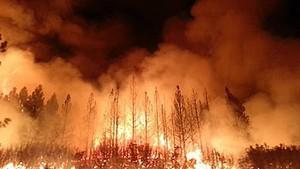Wildfires“It eats everything” – the new breed of wildfire that’s impossible to predict
Climate change and negligent forest management are causing higher-intensity, faster-moving fires that can generate enough energy to evolve into erratic firestorms, known as pyroCbs, in the face of which first responders can do little.

Climate change claimed to be intensified by climate change // Source: wikipedia.org
Climate change and negligent forest management are causing higher-intensity, faster-moving fires that can generate enough energy to evolve into erratic firestorms, known as pyroCbs, in the face of which first responders can do little. “Traditionally we could predict the fire behavior and the direction of the fire but under those conditions and those moments it’s not possible,” said Marc Castellnou, president of the Spanish independent wildfire prevention group Pau Costa Foundation.
As a wildland fire analyst with the Catalan fire services, Castellnou reconstructs wildfires using simulations, satellite, on-the-ground and other data.
This wildfire shows a different behaviour than those of the past, he says. ”It eats everything.”
While these fires are rare, when one strikes it can generate 100,000 kilowatts of energy per meter. In firefighting terms, this is ten times what a firefighter can handle, but even at 4,000 kilowatts, firefighters cannot go near the flames and require aerial support. ”The old way of fighting fires by sending firefighters – that’s gone,” Castellnou said.
New normal
There have been signs of trouble since the 1990s, according to Castellnou.
“This change has been cooking for a long time, but the first time we realized something wrong was happening were the years 2009 and 2012,” he said, referring to the Black Saturday bushfires in the Australian state of Victoria that killed 173 people and wildfires in Spain, Portugal, Chile and California, US. Many in the fire community initially thought these were just abnormal events, he says.
But then wildfires in Chile and Portugal in 2017 indicated that those weren’t simply extreme years. “That was the new normal arriving. 2018 has confirmed that,” he said, referring to the deadly wildfires in Greece and in California.
On October 15, 2017, Castellnou was in central Portugal to conduct analysis then support the local services as the wildfires became firestorms.
“What I saw was the pace of the fires … You think: “Well that cannot be real.” When you go there (and see the damage) you understand that that is the reality,” he said.
